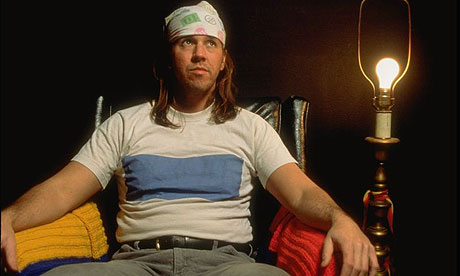Light in the darkness of David Foster Wallace
A prodigious amount has been written about David Foster Wallace since the heart-rending news of his suicide last September. The outpouring continues. This week, a humorous essay that keyed off Wallace’s hyper-baroque writing has seen a viral revival on the Web. Earlier this month, the New Yorker published a lengthy epilogue along with an excerpt from Wallace’s unfinished novel, “The Pale King.” His much-admired speech to the 2005 graduating class at Kenyon College in Ohio will come out in book form in April.
I finally had time to read the long New Yorker piece, and it made me realize that the world also deserves a published collection of Wallace’s correspondence, with fellow writer Jonathan Franzen, his literary agent Bonnie Nadell and others. The varied bits of it appearing in the New Yorker cast additional light on his humanity and highly emotive lexicon.

Steve Liss/Getty/Time Life
There is much insight and lyricism to be found in Wallace’s fiction, but it can be hard to track down and enjoy amid all the dense, cerebral text. He played language not as an instrument but as a postmodern orchestra, and it could get too cacophonous. (I remember when Bob Watts gave me his hardcover copy of “Oblivion,” barely cracked into. “Couldn’t really do it,” he said.) Although I much admired some of Wallace’s earlier short stories, I’ve always thought that he was at his best with essays and literary journalism. It seems the epistolary form (actual letters as well as email) brought out a more direct spirit of his, too, however painful. While in a deep rut in May 1990 he wrote to Franzen:
Right now, I am a pathetic and very confused young man, a failed writer at 28 who is so jealous, so sickly searingly envious of you and [William] Vollmann and Mark Leyner and even David fuckwad Leavitt and any young man who is right now producing pages with which he can live, and even approving them off some base clause of conviction about the enterprise’s meaning and end.
There was also a vivid kind of humor: In another correspondence with Franzen about 15 years later, this time regarding his struggles with “The Pale King,” Wallace wrote, “The whole thing is a tornado that won’t hold still long enough for me to see what’s useful and what isn’t … I’ve brooded and brooded about all this till my brooder is sore.”
One of his former editors recalls Wallace also comparing the writing of the novel with “trying to carry a sheet of plywood in a windstorm.”
For me, one of Wallace’s most memorable essays was published in August 2006 in the magazine Play, in which he profiled tennis titan Roger Federer.
A top athlete’s beauty is next to impossible to describe directly. Or to evoke. Federer’s forehand is a great liquid whip, his backhand a one-hander that he can drive flat, load with topspin, or slice — the slice with such snap that the ball turns shapes in the air and skids on the grass to maybe ankle height. His serve has world-class pace and a degree of placement and variety no one else comes close to; the service motion is lithe and uneccentric, distinctive (on TV) only in a certain eel-like all-body snap at the moment of impact. His anticipation and court sense are otherworldly, and his footwork is the best in the game — as a child, he was also a soccer prodigy. All this is true, and yet none of it really explains anything or evokes the experience of watching this man play. Of witnessing, firsthand, the beauty and genius of his game. You more have to come at the aesthetic stuff obliquely, to talk around it, or — as Aquinas did with his own ineffable subject — to try to define it in terms of what it is not.
It remains a memorable passage because it illumes not only Wallace’s profound talent, but also, in some sense, the linguistic-spiritual puzzle he died still trying to solve. He tells you it can’t be done and then he nearly does it, brilliantly. A deeper look at his personal correspondences — when presumably he was writing more free of the crushing performance pressures he put on himself — could only add to the picture.
This hits things nicely. I would also like to see a collection of his letters, as it is often there (for many writers) that the germs of important artistic projects begin, though in more raw formations. I’d like to see the unpolished Wallace. And, while we’re at it, I’d like to see letters written by a writer in a day and age when lightning email correspondences have all but supplanted high quality missives.
[…] Wallace was at his best with essays and literary journalism; as I wrote about here recently, gems found in his private correspondences show how the epistolary form (actual letters as well as email) brought out a more direct spirit of […]
[…] Wallace captured it best in his 2006 essay, “Federer as Religious Experience.” (Which I discussed here not long ago.) After asserting that a top athlete’s beauty is “impossible to describe […]